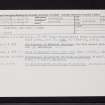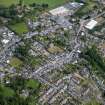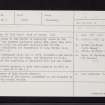Scheduled Maintenance
Please be advised that this website will undergo scheduled maintenance on the following dates: •
Tuesday 3rd December 11:00-15:00
During these times, some services may be temporarily unavailable. We apologise for any inconvenience this may cause.
Abernethy, Old Parish Church
Church (Early Medieval)
Site Name Abernethy, Old Parish Church
Classification Church (Early Medieval)
Canmore ID 27925
Site Number NO11NE 2
NGR NO 1902 1640
Datum OSGB36 - NGR
Permalink http://canmore.org.uk/site/27925
- Council Perth And Kinross
- Parish Abernethy (Perth And Kinross)
- Former Region Tayside
- Former District Perth And Kinross
- Former County Perthshire
NO11NE 2.00 1902 1640
NO11NE 2.01 c. 1900 1641 Stone: Ogam-inscribed (Abernethy no. 2)
NO11NE 2.02 190 164 Sculptured Stone (Abernethy no. 5)
NO11NE 2.03 1897 1643 Gravestone (Abernethy no. 7)
For adjacent round tower (NO 1899 1638) and present parish church (NO 1899 1644), see NO11NE 1 and NO11NE 91 respectively. For (traditionally adjacent) 'Culdee's monastery', see NO11NE 3.
(Area: NO 1902 1640) Site of Church (NR)
OS 25" map, Perthshire, (1901)
The ruins of the church of Abernethy stood in the centre of the present graveyard until 1802, when they were removed to build the present church (Name Book 1860). The Pictish Chronicle attributes its foundation to King Nectan (AD. 457 to 481) (W F Skene 1886-90).
King Gartnaidh (AD. 584 to 599), founded a new church where the earlier one had been, and dedicated it to St. Bridgid (W F Skene 1886-90) who according to Spotswood died and was buried there. The church appears to have been monastic as well as parochial. (See NO11NE 3)
Name Book 1860; W F Skene 1886-90; F Crosse 1791.
No trace of this church remains. The centre of the present graveyard is now occupied by three family burial vaults.
Visited by OS (W D J) 4 August 1965.
The parish church and burial-ground of Abernethy lie in the heart of the village, on the N side of the square. The present church, which occupies the N end of the burial-ground, is of early 19th-century date. However, the N wall and both gables, which are of rubble construction, incorporate numerous blocks of shaped grey sandstone masonry from an earlier building. A red sandstone block in the N wall of the church bears a roll-moulding along one edge. Another stone, with a narrow chamfer, has been reused in the basal course of the NW corner of the Moncrieff burial-enclosure. The burial-ground, which is rectangular in plan and enclosed by a high wall of quarried rubble, contains monuments and enclosures of mainly 19th-century date.
Visited by RCAHMS (IF, JRS), 27 November 1996.


















